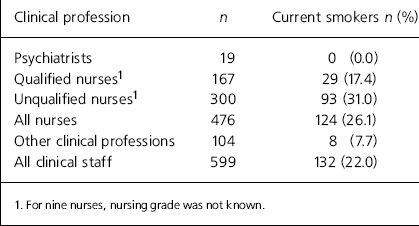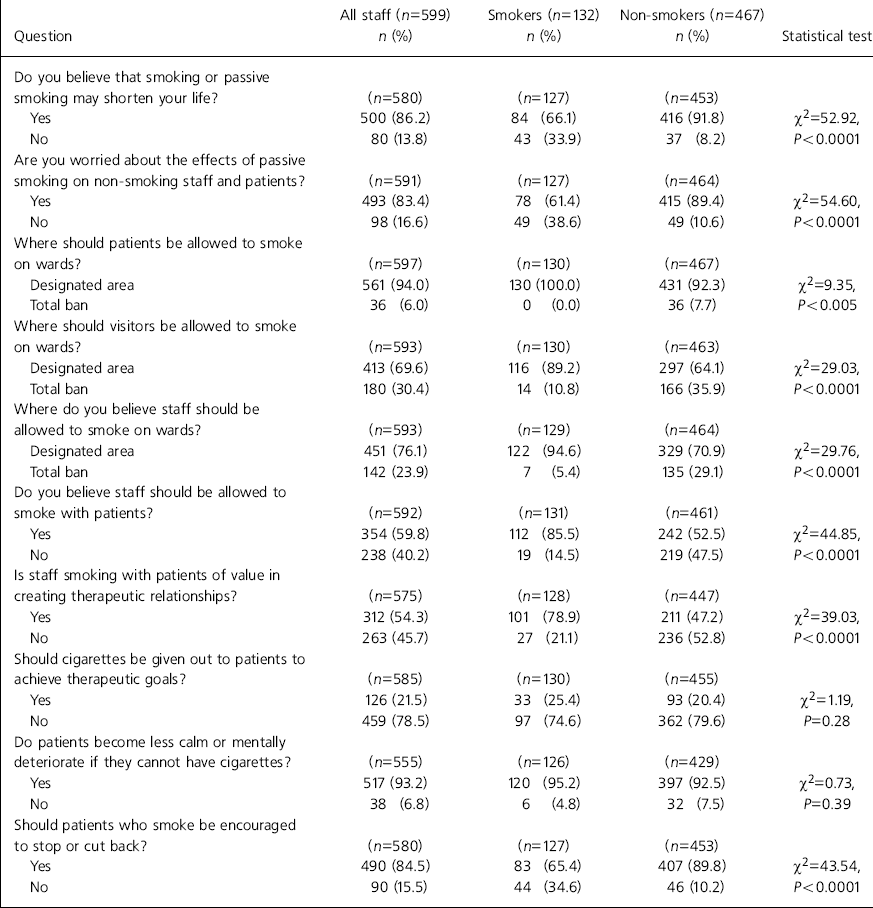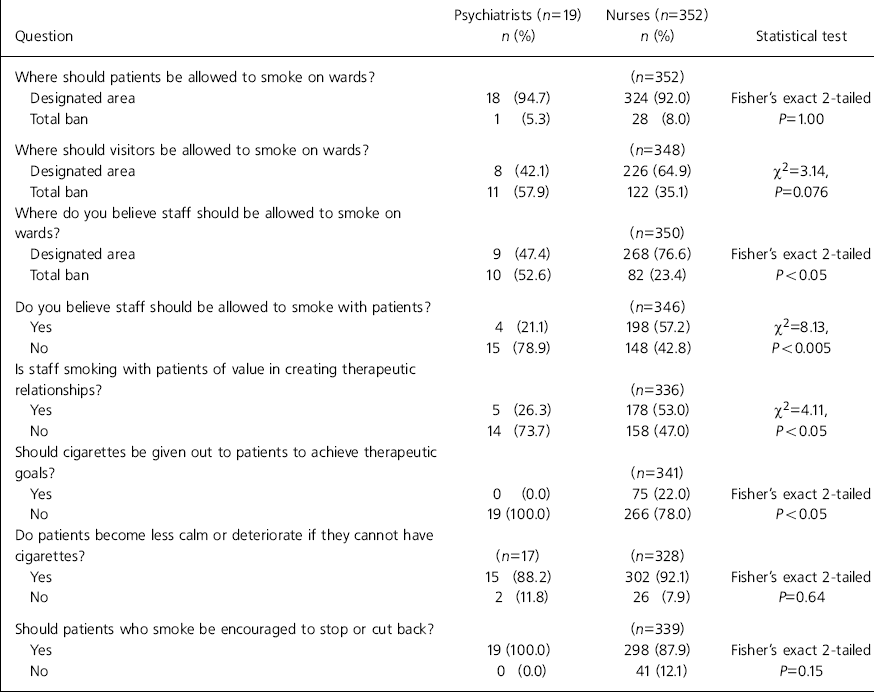Smoking is the single greatest cause of preventable illness and premature death in the UK, killing over 120 000 people annually (Department of Health, 1998). The prevalence of smoking in psychiatric patients is much higher than the rate of 27% found in the UK general population. A study in the USA found that 52% of psychiatric out-patients smoked, with particularly high rates in patients with schizophrenia (88%) and mania (70%) (Reference Hughes, Hatsukami and MitchellHughes et al, 1986). A survey of patients in a UK medium secure unit reported that 84% were smokers (Reference Meiklejohn, Sanders and ButlerMeiklejohn et al, 2003). There is a paucity of information about the prevalence of smoking in mental health professionals. One study found that psychiatric nurses had a smoking prevalence rate twice that of other nurses (Reference GubbayGubbay, 1992). An Israeli study reported higher rates of smoking among psychiatric unit staff than in the general population (Reference Mester, Toren and Ben-MosheMester et al, 1993). Less than 5% of British doctors now smoke, although separate figures for psychiatrists are not available.
Smoking has increasingly been banned from work and public places. In the USA and Australia there are now smoke-free prisons, hospitals and even psychiatric units. In the UK, many psychiatric units permit patients (and sometimes staff) to smoke in designated areas, but central policy now requires health care trusts to move towards being smoke-free (Health Development Agency, 2001). However, persuading psychiatric patients to stop smoking is very difficult (Reference Hughes and FrancesHughes & Frances, 1995).
St Andrew’s Hospital in Northampton is a 500-bed charitable hospital offering specialist psychiatric treatment to people with a wide range of mental health problems. The majority of wards are locked. The hospital’s smoking policy permits patients, visitors and staff to smoke in designated areas only. Each ward has a designated smoking area for patients. On some wards this area is also the designated staff smoking area; other wards have a separate staff smoking room. A ward survey in November 2002 asked ward managers to give the numbers of smokers and non-smokers on or attached to their wards. Returns indicated that 59% of patients and 35% of clinical staff were smokers. Smoking was more common in unqualified than qualified nurses (45% v. 32%).
The aim of this survey was to explore staff attitudes towards smoking in a large psychiatric hospital. Our hypothesis was that smokers would have different views from non-smokers, and that psychiatrists would have different views from nurses.
Method
Approval for the study was obtained from the hospital’s research committee. In January 2003, all clinical staff of St Andrew’s Hospital were sent a postal questionnaire asking about their smoking habits and attitudes towards smoking at work. The questionnaire was devised after reviewing the literature about smoking attitudes in the workplace (Reference Garratt, Gough and TaylorGarratt et al, 1978; Reference Hussain, Tjeder-Burton and CampbellHussain et al, 1993). We piloted the questionnaire before finalising its format. The chi-squared (with Yates’ correction) and Fisher’s exact tests were used to test for differences in responses between smokers and non-smokers, and between psychiatrists and nurses.
Results
The overall response rate was 599/1471 (40.7%). Psychiatrists had the highest response rate (19/29; 65.5%) and nurses the lowest (476/1271; 37.5%), with an intermediate response rate from other clinical professions such as psychologists, occupational therapists and social workers (104/171; 60.8%). The numbers of smokers by professional group is shown in Table 1; 22% of respondents were smokers.
Table 1. Smoking status of respondents by professional group

| Clinical profession | n | Current smokers n (%) |
|---|---|---|
| Psychiatrists | 19 | 0 (0.0) |
| Qualified nurses1 | 167 | 29 (17.4) |
| Unqualified nurses1 | 300 | 93 (31.0) |
| All nurses | 476 | 124 (26.1) |
| Other clinical professions | 104 | 8 (7.7) |
| All clinical staff | 599 | 132 (22.0) |
The findings for all staff, smokers and non-smokers are shown in Table 2. Most staff believed that exposure to tobacco smoke might shorten their lives (500/580; 86.2%). Non-smokers were more concerned that passive smoking might shorten their life than smokers were that smoking might shorten their life (91.8% v. 66.1%; χ2=52.92, P<0.0001). More non-smokers than smokers were concerned about the effects of passive smoking on non-smoking staff and patients (89.4% v. 61.4%; χ2=54.60, P<0.0001). Almost all respondents thought that patients should be allowed to smoke in designated areas (561/597; 94.0%) and that patients became less calm, or deteriorated, if they could not have cigarettes (517/555; 93.2%). A smaller majority thought that visitors (413/593; 69.6%) and staff (451/593; 76.1%) should be allowed to smoke in designated areas. Non-smokers were more likely than smokers to favour a total ban on smoking on the wards by staff, patients and visitors (Table 2). A lower proportion of non-smokers than smokers thought that staff should smoke with patients, or that staff smoking with patients was of value in creating therapeutic relationships (47.2% v. 78.9%; χ 2=39.03, P<0.0001). Non-smokers were also more likely to believe that patients who smoke should be encouraged to cut back or stop, although the majority of smokers also believed this (89.8% v. 65.4%; χ2=43.54, P<0.0001). Of the 132 respondents who smoked, 63 (47.7%) said they wanted to stop smoking, although 74 (56.1%) cited job stress as a barrier to stopping smoking.
Table 2. Attitudes towards smoking of smokers and non-smokers

| Question | All staff (n=599) n (%) | Smokers (n=132) n (%) | Non-smokers (n=467) n (%) | Statistical test |
|---|---|---|---|---|
| Do you believe that smoking or passive smoking may shorten your life? | (n=580) | (n=127) | (n=453) | |
| Yes | 500 (86.2) | 84 (66.1) | 416 (91.8) | χ 2=52.92, |
| No | 80 (13.8) | 43 (33.9) | 37 (8.2) | P<0.0001 |
| Are you worried about the effects of passive smoking on non-smoking staff and patients? | (n=591) | (n=127) | (n=464) | |
| Yes | 493 (83.4) | 78 (61.4) | 415 (89.4) | χ 2=54.60, |
| No | 98 (16.6) | 49 (38.6) | 49 (10.6) | P<0.0001 |
| Where should patients be allowed to smoke on wards? | (n=597) | (n=130) | (n=467) | |
| Designated area | 561 (94.0) | 130 (100.0) | 431 (92.3) | χ 2=9.35, |
| Total ban | 36 (6.0) | 0 (0.0) | 36 (7.7) | P<0.005 |
| Where should visitors be allowed to smoke on wards? | (n=593) | (n=130) | (n=463) | |
| Designated area | 413 (69.6) | 116 (89.2) | 297 (64.1) | χ 2=29.03, |
| Total ban | 180 (30.4) | 14 (10.8) | 166 (35.9) | P<0.0001 |
| Where do you believe staff should be allowed to smoke on wards? | (n=593) | (n=129) | (n=464) | |
| Designated area | 451 (76.1) | 122 (94.6) | 329 (70.9) | χ 2=29.76, |
| Total ban | 142 (23.9) | 7 (5.4) | 135 (29.1) | P<0.0001 |
| Do you believe staff should be allowed to smoke with patients? | (n=592) | (n=131) | (n=461) | |
| Yes | 354 (59.8) | 112 (85.5) | 242 (52.5) | χ 2=44.85, |
| No | 238 (40.2) | 19 (14.5) | 219 (47.5) | P<0.0001 |
| Is staff smoking with patients of value in creating therapeutic relationships? | (n=575) | (n=128) | (n=447) | |
| Yes | 312 (54.3) | 101 (78.9) | 211 (47.2) | χ 2=39.03, |
| No | 263 (45.7) | 27 (21.1) | 236 (52.8) | P<0.0001 |
| Should cigarettes be given out to patients to achieve therapeutic goals? | (n=585) | (n=130) | (n=455) | |
| Yes | 126 (21.5) | 33 (25.4) | 93 (20.4) | χ 2=1.19, |
| No | 459 (78.5) | 97 (74.6) | 362 (79.6) | P=0.28 |
| Do patients become less calm or mentally deteriorate if they cannot have cigarettes? | (n=555) | (n=126) | (n=429) | |
| Yes | 517 (93.2) | 120 (95.2) | 397 (92.5) | χ 2=0.73, |
| No | 38 (6.8) | 6 (4.8) | 32 (7.5) | P=0.39 |
| Should patients who smoke be encouraged to stop or cut back? | (n=580) | (n=127) | (n=453) | |
| Yes | 490 (84.5) | 83 (65.4) | 407 (89.8) | χ 2=43.54, |
| No | 90 (15.5) | 44 (34.6) | 46 (10.2) | P<0.0001 |
The views of psychiatrists and nurses are shown in Table 3. In order to eliminate the confounding effect of smoking status, we compared the views of non-smoking nurses with those of the psychiatrists (all of whom were non-smokers). As there was no significant difference between the responses of unqualified and qualified nursing staff, these responses were combined. Psychiatrists were more likely than nurses to favour a total ban on staff smoking and, in particular, on staff smoking with patients. Only five psychiatrists (26.3%) believed that staff smoking with patients was of value in creating therapeutic relationships, whereas 53.0% of nurses thought that it was. No psychiatrist thought that cigarettes should be handed out to patients to achieve therapeutic goals; in contrast, 22.0% of nurses supported this view. All psychiatrists thought that patients who smoke should be encouraged to cut down and stop. Most nurses agreed, although 12.1% did not.
Table 3. Comparison of attitudes towards smoking of psychiatrists and non-smoking nurses

| Question | Psychiatrists (n=19) n (%) | Nurses (n=352) n (%) | Statistical test |
|---|---|---|---|
| Where should patients be allowed to smoke on wards? | (n=352) | ||
| Designated area | 18 (94.7) | 324 (92.0) | Fisher's exact 2-tailed |
| Total ban | 1 (5.3) | 28 (8.0) | P=1.00 |
| Where should visitors be allowed to smoke on wards? | (n=348) | ||
| Designated area | 8 (42.1) | 226 (64.9) | χ 2=3.14, |
| Total ban | 11 (57.9) | 122 (35.1) | P=0.076 |
| Where do you believe staff should be allowed to smoke on wards? | (n=350) | ||
| Designated area | 9 (47.4) | 268 (76.6) | Fisher's exact 2-tailed |
| Total ban | 10 (52.6) | 82 (23.4) | P<0.05 |
| Do you believe staff should be allowed to smoke with patients? | (n=346) | ||
| Yes | 4 (21.1) | 198 (57.2) | χ 2=8.13, |
| No | 15 (78.9) | 148 (42.8) | P<0.005 |
| Is staff smoking with patients of value in creating therapeutic relationships? | (n=336) | ||
| Yes | 5 (26.3) | 178 (53.0) | χ 2=4.11, |
| No | 14 (73.7) | 158 (47.0) | P<0.05 |
| Should cigarettes be given out to patients to achieve therapeutic goals? | (n=341) | ||
| Yes | 0 (0.0) | 75 (22.0) | Fisher's exact 2-tailed |
| No | 19 (100.0) | 266 (78.0) | P<0.05 |
| Do patients become less calm or deteriorate if they cannot have cigarettes? | (n=17) | (n=328) | |
| Yes | 15 (88.2) | 302 (92.1) | Fisher's exact 2-tailed |
| No | 2 (11.8) | 26 (7.9) | P=0.64 |
| Should patients who smoke be encouraged to stop or cut back? | (n=339) | ||
| Yes | 19 (100.0) | 298 (87.9) | Fisher's exact 2-tailed |
| No | 0 (0.0) | 41 (12.1) | P=0.15 |
Discussion
In this survey the majority of staff recognised the risks of tobacco smoke, but most did not favour a total ban on smoking by staff, patients or visitors. Most believed that if patients could not have cigarettes their behaviour would deteriorate. This is an important point, given that many of the patients have a history of criminal offending and exhibit severe behavioural disturbance. Non-smokers, who were the majority, were more concerned about the effect of tobacco smoke and had a more restrictive attitude to smoking by staff and visitors than did smokers. Some staff, predominantly those who smoked, did not think patients should be encouraged to give up smoking. Nursing staff were less restrictive in their attitude towards smoking by staff and visitors than psychiatrists, and were more likely to perceive staff smoking with patients as therapeutic. In contrast, most psychiatrists thought that staff should not smoke with patients.
The study has some methodological weaknesses. Respondents were asked to define themselves as smokers or non-smokers. Thus, long-standing smokers who had recently quit might call themselves non-smokers and their responses might be expected to differ from those of a lifelong non-smoker. Although the response rate of 41% was good for a postal questionnaire, based on the findings of the ward survey, smokers and nurses appeared to be underrepresented. The small number of psychiatrists (19) limits the comparison of psychiatrists’ and nurses’ attitudes. However, the divergence of views is interesting, and points to an area for further research. The findings of this survey relate to staff working in a specialist independent hospital with many long-stay patients, and cannot automatically be generalised to National Health Service acute psychiatric units.
The findings of the few studies that have investigated attitudes of psychiatric staff to smoking contrast with those of this study. A small survey of senior nurse managers of forensic units in the UK found that 46% of respondents believed staff should not smoke in front of patients under any circumstances, and 73% thought that nurses smoking with patients had no value in creating therapeutic relationships (Reference TarbuckTarbuck, 1996). An Israeli study found that many psychiatric nurses often used cigarettes in order to appease patients and a quarter of staff denied the hazards of smoking (Reference Mester, Toren and Ben-MosheMester et al, 1993). Although the practice was widely used in the past, it is now considered unethical to use tobacco as a reward.
There is now an expectation that mental health care trusts will move away from having designated smoking areas for staff (Health Development Agency, 2001). Judging by the results of this survey, a considerable amount of preparatory work would have to be done with staff, especially those who smoke, before such a policy could be successfully implemented. Nevertheless, smoking control programmes can reduce the prevalence of smoking in staff and increase the frequency of advice to patients to quit smoking (Reference Batlle, Boixet and AgudoBatlle et al, 1991). A bigger step would be to make all psychiatric units smoke-free. In North America, such policies have been successfully implemented, with fewer adverse effects than staff anticipated (Reference McneillMcNeill, 2001). In the UK, we are moving slowly but steadily towards smoke-free hospitals and public places, although psychiatric units seem likely to be one of the last places to continue to permit smoking, at least for patients.
Acknowledgements
Thanks to Professor Robin McCreadie, Louise Harriss and Sue Simkin for their comments on the manuscript.






eLetters
No eLetters have been published for this article.